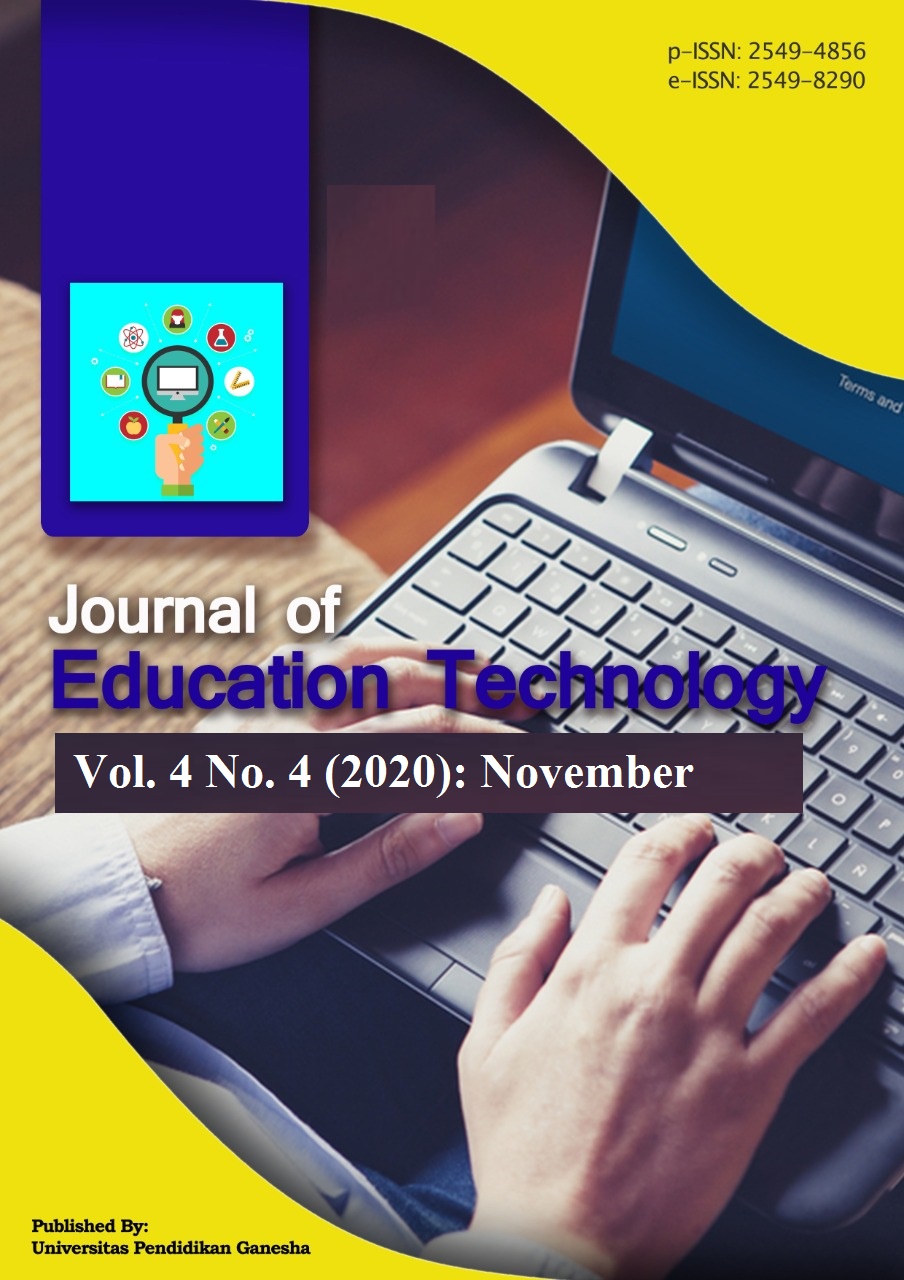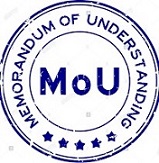E-learning Assissted by Finger Printing on Students’ Critical Thinking and Creativity
DOI:
https://doi.org/10.23887/jet.v4i4.30214Kata Kunci:
online, creativity, critical thinking, finger paintingAbstrak
The impact of covid-19 requires all types of learning activities to be carried out online. The long online learning process results in boredom among students so that the online learning process is not optimal. The research objective was to analyze the effect of e-learning assisted by finger painting on critical thinking skills and student creativity. This type of research is quasi-experimental research, the design of this study used a posttest only control group design. The study population was 180 students in semester III who received basic science concepts courses. The data collection methods used were test and non-test. This study uses two analytical techniques, descriptive analysis, and inferential analysis. Inferential analysis is used to test the research hypothesis. Before analyzing inferential data, the data is tested for normality and homogeneity. In this study, the inferential analysis was assisted by using SPSS 17.00. The results of this research can be said that with the effect of e-learning assisted by finger painting on the critical thinking and creativity abilities of PGSD students, this can be seen from the Manova test results that the resulting significant score is less than 0.05, 0.00. So it can be said that e-learning assisted by finger painting impacts critical thinking and creativity, critical thinking, and PGSD students' creativity.
Referensi
Abusiri, Ekawati, S. H. K. (2019). Implementasi E-learning dalam Upaya Meningkatkan Kreativitas Dosen dan Mahasiswa di STAI. HIKMAH, XV(1), 80–99. https://journal.alhikmahjkt.ac.id/index.php/HIKMAH/article/download/131/95.
Anitha Kumari, T., Hemalatha, C. H., Subhani Ali, M., & Naresh, R. (2020). Survey on impact and learning’s of the online courses on the present era. Procedia Computer Science, 172, 82–91. https://doi.org/10.1016/j.procs.2020.05.167
Anugrahana, A. (2020). Hambatan , Solusi dan Harapan : Pembelajaran Daring Selama Masa Pandemi Covid-19 Oleh Guru Sekolah Dasar. Scholaria: Jurnal Pendidikan Dan Kebudayaan, 10(3), 282–289. https://ejournal.uksw.edu/scholaria/article/view/4033
Arikunto, S. (2015). Dasar-Dasar Evaluasi Pendidikan. Bumi Aksara.
Athena, A., Laelasari, E., & Puspita, T. (2020). Pelaksanaan Disinfeksi Dalam Pencegahan Penularan Covid-19 Dan Potensi Risiko Terhadap Kesehatan Di Indonesia. Jurnal Ekologi Kesehatan, 19(1), 1–20. https://doi.org/10.22435/jek.v19i1.3146
Boussakssou, M., Hssina, B., & Erittali, M. (2020). Towards an Adaptive E-learning System Based on Q-Learning Algorithm. Procedia Computer Science, 170, 1198–1203. https://doi.org/10.1016/j.procs.2020.03.028
Crismono, P. C. (2017). Pengaruh Outdoor Learning Terhadap Kemampuan Berpikir Kritis Matematis Siswa The Influence Of Outdoor Learning On The Mathematical Critical Thinking Skills Of Students. Junal Pendidikan Matematika Dan Sains, 4(2), 106–113. https://doi.org/https://doi.org/10.21831/jpms.v5i2.15482
Dong, C., Cao, S., & Li, H. (2020). Young children’s online learning during COVID-19 pandemic: Chinese parents’ beliefs and attitudes. Children and Youth Services Review, 118(August), 105440. https://doi.org/10.1016/j.childyouth.2020.105440
Duncan, M. J., Smith, M., & Cook, K. (2013). Implementing online problem based learning (PBL) in postgraduates new to both online learning and PBL: An example from strength and conditioning. Journal of Hospitality, Leisure, Sport and Tourism Education, 12(1), 79–84. https://doi.org/10.1016/j.jhlste.2012.11.004
Evivani, M., & Oktaria, R. (2020). Permainan Finger Painting Untuk Pengembangan Kemampuan Motorik Halus Anak Usia Dini. Jurnal Warna : Pendidikan Dan Pembelajaran Anak Usia Dini, 5(1), 23–31. https://doi.org/10.24903/jw.v5i1.427
Faizah, S. (2017). Upaya Meningkatkan Kreativitas Siswa Dalam Menggambar Motif Batik Dengan Metode Discovery-Inquiry. Journal of Chemical Information and Modeling, 110(9), 1689–1699. https://jurnal.untirta.ac.id/index.php/psnp/article/download/5738/4119
Fajariyah, S. N., Suryawan, A., & Atika, A. (2018). Dampak Penggunaan Gawai Terhadap Perkembangan Anak. Sari Pediatri, 20(2), 101. https://doi.org/10.14238/sp20.2.2018.101-5
Gunantara, G., Suarjana, M., & Riastini, P. N. (2019). Penerapan Strategi Pembelajaran Problem Based Learning Untuk Meningkatkan Kemampuan Pemecahahan Masalah Matematis Siswa Kelas IV. Kreano, Jurnal Matematika Kreatif-Inovatif, 10(2), 146–152. https://doi.org/10.15294/kreano.v10i2.19671
Hasibuan, R., & Ningrum, M. A. (2017). Pengaruh Bermain Outdoor Dan Kegiatan Finger Painting Terhadap Kreativitas Anak Usia Dini. Jurnal Pendidikan (Teori Dan Praktik), 1(1), 73. https://doi.org/10.26740/jp.v1n1.p73-81
Horohiung, V., & Sarkadi, M. W. (2016). Pengaruh Strategi Pembelajaran Dan Kemampuan Berpikir Logis Terhadap Hasil Belajar Sejarah Siswa Jurusan Ips Sma Negeri 2 Pematangsiantar. Jurnal Teknologi Pendidikan (JTP), 9(2), 1–10. https://doi.org/10.24114/jtp.v9i2.4900
Hussein, E., Daoud, S., Alrabaiah, H., & Badawi, R. (2020). Children and Youth Services Review Exploring undergraduate students ’ attitudes towards emergency online learning during COVID-19 : A case from the UAE. Children and Youth Services Review, 119(August), 105699. https://doi.org/10.1016/j.childyouth.2020.105699
Ihsan, M. S., Ramdani, A., & Hadisaputra, S. (2019). Efektivitas Model Blended Learning Dalam Pembelajaran Kimia Untuk Meningkatkan Kemampuan Berpikir Kritis Peserta Didik. Jurnal Pijar Mipa, 14(2), 84–87. https://doi.org/10.29303/jpm.v14i2.1238
Kacetl, J., & Semradova, I. (2020). Reflection on blended learning and e-learning - case study. Procedia Computer Science, 176, 1322–1327. https://doi.org/10.1016/j.procs.2020.09.141
Kurniawati, A., Hastuti, W. D., & Prehedhiono, H. (2018). The Effect of Finger Painting towards Fine Motor Skill of Intellectual Disability. Penelitian Dan Pengembangan Pendidikan Luar Biasa, 5(1), 47–51. https://doi.org/http://dx.doi.org/10.17977/um029v5i12018p047
Mahitsa, M., & Mahardini, A. (2020). Analisis Situasi Penggunaan Google Classroom pada Pembelajaran Daring Fisika. Jurnal Pendidikan FIsika, VIII(2), 215–224. https://doi.org/http://dx.doi.org/10.24127/jpf.v8i2.3102 ANALISIS
Martadini, E. (2016). The Influence of Finger Painting Game to Increase Writing Letter Ability For Moderate Retardation Learner. P3Lb, 3(1), 54–60. http://journal2.um.ac.id/index.php/jppplb/article/view/4342
Maulana, H. A. &, & Iswari, R. D. (2020). Analisis Tingkat Stres Mahasiswa Terhadap Pembelajaran Daring Pada Mata Kuliah Statistik Bisnis di Pendidikan Vokasi. Jurnal Ilmiah Kependidikan, 14(1), 17–30. https://doi.org/10.30595/jkp.v14i1.8479
Mayora, E., Junaidi, J., & Rusdi, R. (2018). Hubungan Antara Kreativitas Siswa dengan Hasil Belajar Matematika Siswa Kelas VIII SMP Negeri 1 X Koto Di Atas Kabupaten Solok Tahun Pelajaran 2017/2018. JURING (Journal for Research in Mathematics Learning), 1(1), 254. https://doi.org/10.24014/juring.v1i3.7274
Mishra, D. L., Gupta, D. T., & Shree, D. A. (2020). Online Teaching-Learning in Higher Education during Lockdown Period of COVID-19 Pandemic. International Journal of Educational Research Open, August, 100012. https://doi.org/10.1016/j.ijedro.2020.100012
Mitra, N. K., Aung, H. H., Kumari, M., & Perera, J. (2020). Improving the learning process in anatomy practical sessions of chiropractic program using e-learning tool. Translational Research in Anatomy, 100100. https://doi.org/10.1016/j.tria.2020.100100
Murniati, M., Sulistyo, S., & Yudiono, U. (2019). Pengaruh Kepribadian, Pengetahuan Kewirausahaan, Kreativitas Dan Lingkungan Keluarga Terhadap Minat Berwirausaha. Jurnal Riset Pendidikan Ekonomi, 4(2), 1–6. https://doi.org/10.21067/jrpe.v4i2.3908
Nagge, J. J., Killeen, R., & Jennings, B. (2018). Using a course pilot in the development of an online problem-based learning (PBL) therapeutics course in a post-professional PharmD program. Currents in Pharmacy Teaching and Learning, 10(2), 231–234. https://doi.org/10.1016/j.cptl.2017.10.005
Pradana, G. A., Darsono, & Rufaidah, E. (2018). Pengembangan Lkpd E-Learning Schoology Meningkatkan Kemampuan Berpikir Kritis Dan Hasil Belajar Sejarah. Jurnal Studi Sosial, 6(1), 13–25. http://jurnal.fkip.unila.ac.id/index.php/JSS/article/view/15328
Rahmawati, M., & Latifah, M. (2020). Penggunaan Gawai, Interaksi Ibu-Anak, Dan Perkembangan Sosial-Emosional Anak Prasekolah. Jur. Ilm. Kel. & Kons., 13(1), 75–86. https://doi.org/DOI: http://dx.doi.org/10.24156/jikk.2020.13.1.75
Rahzianta, & Hidayat, M. L. (2016). Pembelajaran Sains Model Service Learning Sebagai Upaya Pembentukan Habits of Mind Dan Penguasaan Keterampilan Berpikir Inventif. USEJ - Unnes Science Education Journal, 5(1), 1128–1137. https://doi.org/10.15294/usej.v5i1.9646
Ratini, Muchtar, H., Suparman, M. A., Tamuri, A. H., & Susanto, E. (2018). The influence of learning models and learning reliance on students’ scientific literacy. Jurnal Pendidikan IPA Indonesia, 7(4), 458–466. https://doi.org/10.15294/jpii.v7i4.12489
Riftanto, A. A. (2019). Efektivitas Permainan Finger Painting Terhadap Effectiveness Of Finger Painting Game On Ability To. Jurnal Widia Ortodidaktika, 8(9), 888–900. http://journal.student.uny.ac.id/ojs/ojs/index.php/plb/article/viewFile/16172/15650
Rohimah, R., Riswandi, R., & Fitriawan, H. (2020). Pengembangan Media Pembelajaran Informatika Melalui E-Learning untuk Meningkaykan Berpikir Kreatif Siswa. Jurnal KajianTeknologi Pendidikan, 3(3), 330–339. https://doi.org/10.17977/um038v3i32020p330
Samaha, M., & Hawi, N. S. (2016). Computers in Human Behavior Relationships among smartphone addiction , stress , academic performance , and satisfaction with life. Computers in Human Behavior, 57, 321–325. https://doi.org/10.1016/j.chb.2015.12.045
Sambada, D. (2012). Peranan Kreativitas Siswa Terhadap Kemampuan Memecahkan Masalah Fisika Dalam Pembelajaran Kontekstual. Jurnal Penelitian Fisika Dan Aplikasinya (JPFA), 2(2), 37. https://doi.org/10.26740/jpfa.v2n2.p37-47
Sari, R. M. M., & Priatna, N. (2020). Model-Model Pembelajaran di Era Revolusi Industri 4.0 (E-Learning, M-Learning, AR-Learning dan VR-Learning). Jurnal Ilmiah Fakultas Keguruan Dan Ilmu Pendidikan, 6(1), 107–115.
Şendaǧ, S., & Ferhan Odabaşi, H. (2009). Effects of an online problem based learning course on content knowledge acquisition and critical thinking skills. Computers and Education, 53(1), 132–141. https://doi.org/10.1016/j.compedu.2009.01.008
Setyaningsih, T. D., Agoestanto, A., & Kurniasih, A. W. (2014). Identifikasi Tahap Berpikir Kritis Siswa Menggunakan PBL dalam Tugas Pengajuan Masalah Matematika. Kreano: Jurnal Matematika Kreatif-Inovatif, 5(2), 180–187. https://doi.org/10.15294/kreano.v5i2.4544
Simanjuntak, M. (2017). Model Pembelajaran Kooperatif Think-Talk-Write (Ttw) Dan Software Autograph Dalam Mempersiapkan Pendidik Matematika Menghadapi Masyarakat Ekonomi Asean (Mea). Jurnal Dinamika Pendidikan, 9(2), 71. https://doi.org/10.33541/jdp.v9i2.339
Sudarti, & Putra, P. D. A. (2015). Real Life Video Evaluation Dengan Sistem E-Learning Untuk Meningkatkan Keterampilan Berpikir Kritis Mahasiswa. Jurnal Kependidikan: Penelitian Inovasi Pembelajaran, 45(1), 107696. https://doi.org/10.21831/jk.v45i1.7187
Taiyeb, H. (2016). Kemampuan motorik halus melalui teknik finger painting anak down syndrome. Jurnal Psikologi Pendidikan Dan Konseling: Jurnal Kajian Psikologi Pendidikan Dan Bimbingan Konseling, 2(2), 93. https://doi.org/10.26858/jpkk.v2i2.2159
Waty, N. L., Sumarmi, S., & Susilo, S. (2018). Peningkatan Kreativitas Belajar Peserta Didik pada Mata Pelajaran Geografi melalui Model Blended Learning di Sekolah Menengah Atas. Jurnal Pendidikan: Teori, Penelitian, Dan Pengembangan, 3(1), 9–14. https://doi.org/http://dx.doi.org/10.17977/jptpp.v3i1.10353
Wong, G. L. H., Wong, V. W. S., Thompson, A., Jia, J., Hou, J., Lesmana, C. R. A., Susilo, A., Tanaka, Y., Chan, W. K., Gane, E., Ong-Go, A. K., Lim, S. G., Ahn, S. H., Yu, M. L., Piratvisuth, T., & Chan, H. L. Y. (2020). Management of patients with liver derangement during the COVID-19 pandemic: an Asia-Pacific position statement. The Lancet Gastroenterology and Hepatology, 5(8), 776–787. https://doi.org/10.1016/S2468-1253(20)30190-4
Xiong, W., Mok, K. H., Ke, G., Oi, J., & Cheung, W. (2020). Impact of COVID-19 Pandemic on International Higher Education and Student Mobility : Student Perspectives from Mainland China and Hong Kong. Centre for Global Higher Education, 105(August 2020), 101718. https://doi.org/10.1016/j.ijer.2020.101718
Zulkarnaen, R. (2015). Pengaruh Model Eliciting Activities Terhadap Kreativitas Matematis Pada Siswa Kelas Viii Pada Satu Sekolah Di Kab. Karawang. Infinity Journal, 4(1), 32. https://doi.org/10.22460/infinity.v4i1.69.
Unduhan
Diterbitkan
Cara Mengutip
Terbitan
Bagian
Lisensi
Authors who publish with the Journal of Education Technology agree to the following terms:
- Authors retain copyright and grant the journal the right of first publication with the work simultaneously licensed under a Creative Commons Attribution License (CC BY-SA 4.0) that allows others to share the work with an acknowledgment of the work's authorship and initial publication in this journal.
- Authors are able to enter into separate, additional contractual arrangements for the non-exclusive distribution of the journal's published version of the work (e.g., post it to an institutional repository or publish it in a book), with an acknowledgment of its initial publication in this journal.
- Authors are permitted and encouraged to post their work online (e.g., in institutional repositories or on their website) prior to and during the submission process, as it can lead to productive exchanges, as well as earlier and greater citation of published work. (See The Effect of Open Access)


















